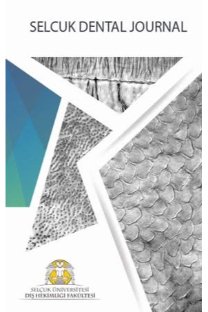Non-surgical management of dens invaginatus in a mandibular premolar with periapical lesion: report of a type II invagination
Periapikal lezyonlu bir mandibular premolardaki dens invaginatusun cerrahi olmayan tedavisi: bir tip II invaginasyon raporu
___
- 1. Hulsmann M. Dens invaginatus: aetiology, classification, prevalence, diagnosis, and treatment considerations. Int Endod J. 1997; 30: 79-90.
- 2. Segura JJ, Hattab F, Rios V. Maxillary canine transpositions in two brothers and one sister: associated dental anomalies and genetic basis. ASDC J Dent Child. 2002; 69: 54-8, 12.
- 3. Alani A, Bishop K. Dens invaginatus. Part 1: classification, prevalence and aetiology. Int Endod J. 2008; 41: 1123- 36.
- 4. Boyne PJ. Dens in dente: report of three cases. J Am Dent Assoc. 1952; 45: 208-9.
- 5. Cakici F, Celikoglu M, Arslan H, et al. Assessment of the prevalence and characteristics of dens invaginatus in a sample of Turkish Anatolian population. Med Oral Patol Oral Cir Bucal. 2010; 15: e855-8.
- 6. Hamasha AA, Alomari QD. Prevalence of dens invaginatus in Jordanian adults. Int Endod J. 2004; 37: 307-10.
- 7. Canger EM, Kayipmaz S, Celenk P. Bilateral dens invaginatus in the mandibular premolar region. Indian J Dent Res. 2009; 20: 238-40.
- 8. Hartup GR. Dens invaginatus type III in a mandibular premolar. Gen Dent. 1997; 45: 584-7.
- 9. Tavano SM, de Sousa SM, Bramante CM. Dens invaginatus in first mandibular premolar. Endod Dent Traumatol. 1994; 10: 27-9.
- 10. Oehlers FA. Dens invaginatus (dilated composite odontome). I. Variations of the invagination process and associated anterior crown forms. Oral Surg Oral Med Oral Pathol. 1957; 10: 1204-18 contd.
- 11. Jung M. Endodontic treatment of dens invaginatus type III with three root canals and open apical foramen. Int Endod J. 2004; 37: 205-13.
- 12. Keles A, Cakici F. Endodontic treatment of a maxillary lateral incisor with vital pulp, periradicular lesion and type III dens invaginatus: a case report. Int Endod J. 2010; 43: 608-14.
- 13. Nallapati S. Clinical management of a maxillary lateral incisor with vital pulp and type 3 dens invaginatus: a case report. J Endod. 2004; 30: 726-31.
- 14. Tsurumachi T, Hayashi M, Takeichi O. Non-surgical root canal treatment of dens invaginatus type 2 in a maxillary lateral incisor. Int Endod J. 2002; 35: 310-4.
- 15. Chen YH, Tseng CC, Harn WM. Dens invaginatus. Review of formation and morphology with 2 case reports. Oral Surg Oral Med Oral Pathol Oral Radiol Endod. 1998; 86: 347-52.
- 16. Kristoffersen O, Nag OH, Fristad I. Dens invaginatus and treatment options based on a classification system: report of a type II invagination. Int Endod J. 2008; 41: 702-9.
- 17. Mupparapu M, Singer SR. A rare presentation of dens invaginatus in a mandibular lateral incisor occurring concurrently with bilateral maxillary dens invaginatus: case report and review of literature. Aust Dent J. 2004; 49: 90-3.
- 18. Bishop K, Alani A. Dens invaginatus. Part 2: clinical, radiographic features and management options. Int Endod J. 2008; 41: 1137-54.
- ISSN: 1300-5170
- Yayın Aralığı: Yılda 3 Sayı
- Başlangıç: 1991
- Yayıncı: İsmail Marakoğlu
Betül GÜNEŞ, Hale AYDINBELGE ARI
In vitro evaluation of marginal leakage using various temporary filling materials
Ayçe ELDENİZ ÜNVERDİ, MAKBULE BİLGE AKBULUT, MEHMET BURAK GÜNEŞER
Toplumumuzda diş ipi kullanma alışkanlığı
Hakan ARSLAN, Çağatay BARUTCİGİL, Duygu KÜRKLÜ, Hüseyin ERTAŞ
Leyla B. AYRANCI, Hakan ARSLAN, H. Sinan TOPÇUOĞLU
Zirkonya: Yapısı ve altyapı üretim tekniği
Obezitenin tükürük PH'sı, tamponlama kapasitesi ve diş çürüğü insidansı'na etkisi+
Abdulkadir ŞENGÜN, NAZMİYE DÖNMEZ, İsmet DURAN, H.Esra ÜLKER
Tooth shade assessment after lingual retainer application: A prospective clinical trial
Hasan Önder GÜMÜŞ, Faruk İzzet UÇAR, Hayriye ŞENTÜRK, Tancan UYSAL
İki farklı porselen laminate veneer restorasyonun kenar uyumunun in-vitro olarak değerlendirilmesi+
MERAL ARSLAN MALKOÇ, Atiye Nilgün ÖZTÜRK, Şerife Tuba BÜYÜKÖZER, Bora ÖZTÜRK
